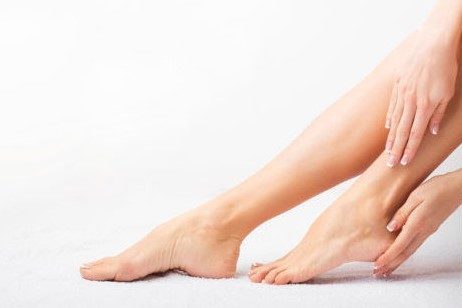By Professor Mark Whiteley, the leading venous consultant in the UK and Founder of The Whiteley Clinic.
While many people suffer from skin conditions, there is often a tendency to dismiss or ignore the issue – deeming it ‘cosmetic’ – allowing the problem to fester and cause more long-term damage. Many remain unaware that some skin conditions can in fact, be symptoms of more serious conditions like varicose veins, leg ulcers or even blood clots, which is why it is so vital that they are diagnosed earlier rather than later.
Here are five unusual skin conditions that you might not know about but can easily be treated:
Venous Eczema
Many people remain unaware that dry or itchy skin on the legs, and especially the lower legs or ankles, can be an indication of varicose veins or “hidden varicose veins”. When a person has had varicose veins for some time, the constant irritation of the blood falling the wrong way down the bad veins causes the overlying skin to become inflamed. This leaves the skin itchy and dry – called “venous eczema”.
In some cases where the skin has become tender or sore, in the lower part of the leg, it can be a sign that the varicose vein condition has become more problematic and a venous leg ulcer is beginning to form.
To prevent this issue from escalating, it is important to have a venous duplex ultrasound performed by an experienced venous specialist like myself who can then recommend appropriate treatment on a case-by-case basis. I developed ‘The Whiteley Protocol’ which allows our experts at the clinic to tailor treatment options to each individual – making sure that when treatment is finished, there is no blood refluxing down any veins in the pelvis or leg, stopping any inflammation and therefore letting the Venous Eczema heal.

Haemosiderin
For those that find yellow, red, or brown stains appear on their skin, it’s likely that there’s a deeper cause, as the marks are often a key indicator of varicose veins or “hidden varicose veins”. This is because varicose veins can cause skin damage to the ankles, resulting in yellow, red, or brown stains, known as haemosiderin.
Haemosiderin occurs when the blood refluxes the wrong way down towards the veins, causing chronic inflammation which turns the skin brown. Often the skin and underlying tissue can become inflamed and harder. If the underlying varicose veins are not treated, the skin damage will continue, and you could eventually develop a serious venous ulcer.
In terms of treatment, research shows that haemosiderin can be effectively broken apart by laser. I recommend using a combined laser technique with a topical skincare regime to remove these marks from the skin. It is important to remember that the number of treatments necessary will depend on the size of the mark and the darkness.
Phlebitis
If you happen to notice a hard lump appear near the surface of the skin that is very tender to pressure, it is likely that you are experiencing clotting in a varicose vein.
This is often misdiagnosed by general practitioners or nurses as “infection” and they often give antibiotics which is quite wrong.
This condition often known as “phlebitis” needs a duplex ultrasound scan to check the clot is not near the deep veins and treatment of the inflammation and clot which might be blood thinners or nonsteroidal anti-inflammatory is and support stockings. To stop it from happening again, the varicose veins or hidden varicose veins need to be treated.
Pigmented Purpuric Dermatosis
Pigmented Purpuric Dermatosis, also known as PPD, is a rarer condition that causes red, purple or brown stains on the skin, particularly the lower legs. Although the marks may appear like those of Haemosiderin, patients with pigmented purpuric dermatosis do not have any underlying varicose veins.
In this instance, the little blood vessels called capillaries are “leaky”, causing red blood cells to get outside of the capillaries under the skin. Initially, this causes a red or purple discolouration but as the blood breaks down, it turns a golden brown or brown colour.
In most cases, it is safe to leave pigmented purpuric dermatosis alone. However, for those concerned about the symptoms (aching and swelling), the simplest treatment with very few risks is to wear compression stockings. In addition, bioflavonoid tablets with vitamin C can also help.
Lipodermatosclerosis (Champagne bottle legs)
Development of hard, shiny patches around the lower leg – under the calf muscle but above the ankle bone, is called “Lipodermatosclerosis” or “LDS”. This literally means “Fat and skin hardening”. It is the result of chronic inflammation of the tissue secondary to varicose veins or “hidden varicose veins” that have not been found or treated.
If left, it can spread around the lower leg, making the ankle very thin – but the tissue is hard and the skin shiny. The soft bulging calf then spread out, making the lower leg look like an upside down Champagne bottle.
If the underlying veins are not treated, the skin will break down in to a chronic sore – called a “venous leg ulcer”. Anyone with this condition must have a venous duplex ultrasound and endovenous treatment of their leg veins.
The Whiteley Clinic is now running a Covid-secure service in Guildford, London and Bristol, as well as virtual consultations, for those who might need urgent care for their veins. For more information about treatments offered by The Whiteley Clinic please visit www.thewhiteleyclinic.co.uk
About the expert
 Professor Mark Whiteley is the UK’s leading Consultant Vascular Surgeon specialising in walk-in, walk-out surgery for varicose veins. He trained at St. Bartholomew’s Hospital in London and was a lecturer in surgery at Oxford University from 1995 to 1998. Mark was appointed Consultant Vascular Surgeon in 1998 and performed the first endovenous “keyhole” surgery for varicose veins in the UK in March 1999. As the founder of The Whiteley Clinic and The Whiteley Protocol, his aim was to bring the very best treatments for varicose veins and vein problems, such as thread veins and leg ulcers, to the UK public.
Professor Mark Whiteley is the UK’s leading Consultant Vascular Surgeon specialising in walk-in, walk-out surgery for varicose veins. He trained at St. Bartholomew’s Hospital in London and was a lecturer in surgery at Oxford University from 1995 to 1998. Mark was appointed Consultant Vascular Surgeon in 1998 and performed the first endovenous “keyhole” surgery for varicose veins in the UK in March 1999. As the founder of The Whiteley Clinic and The Whiteley Protocol, his aim was to bring the very best treatments for varicose veins and vein problems, such as thread veins and leg ulcers, to the UK public.
The Whiteley Protocol is now adopted by all surgeons treating varicose veins within The Whiteley Clinic. Mark Whiteley and his team have been at the forefront of developments in this field over the last decade and have won international, national and regional prizes for their research into vein treatments.

